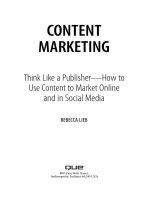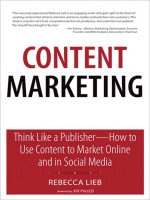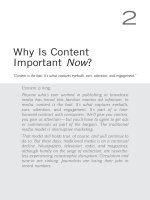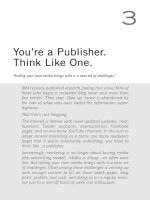Content marketing think like a publisher chapter 13 content and advertising
Bạn đang xem bản rút gọn của tài liệu. Xem và tải ngay bản đầy đủ của tài liệu tại đây (1.22 MB, 8 trang )
13
Content and Advertising
“In digital environments, it’s as easy to become media as it is to buy media.”
Content and advertising have always been either/or
propositions in the context of traditional print and broadcast media. Advertising (or commercials) existed in a
clearly circumscribed periphery outside, or adjacent to,
the main content that was created by the publisher or
broadcaster. Advertising was interruptive. It was the price
that readers or viewers paid to get free or subsidized content. Those lines blurred slightly (but only slightly) in certain contexts, such as “advertorial” sections in magazines.
Advertising—in which an advertiser buys the media in
which they place a commercial message—is still distinct
from editorial content, or programming, but the lines are
blurring in the digital environment. You need only look at
“traditional” publishers including Gannett, Meredith,
Hearst, and most recently Condé Nast, that are buying up
digital technology and digital agencies (or, in some cases,
establishing their own in-house) to help their advertisers
reach deeper into digital marketing with content, apps,
social media programs, ecommerce offerings, and the like.
114
Part III
G e t t i n g Ta c t i c a l : C o n t e n t N u t s & B o l t s
Condé Nast Ideactive, for example, is an in-house agency that specifically goes after
the nonmedia budgets of Condé Nast’s advertising clients. Lou Cona, who heads the
venture, said when it launched in May 2011, “We can tap into our experts if people
want custom content. This is not about repurposing, although some of it could be.
If someone wants custom content related to fashion and beauty, for example, we
have the consumer insights to develop it.”
In other words, experts in content creation such as the firms that publish periodicals ranging from Vogue to The New Yorker are helping brands not only to correctly
situate their ads, but also create compelling content that will appeal to those magazines’ audiences.
Content is what advertisers are demanding. In digital environments, it’s as easy to
become media as it is to buy media. Advertising, advertorial, content…the lines are
blurring in ways that defy precise definitions.
A quasi-advertorial example might be the campaign Coke Light undertook in
France in 2010, partnering both with fashion designer Karl Lagerfeld and with
Yahoo France. In the past the beverage company had asked fashion designers to
redesign the Coke Light bottle. With Lagerfeld’s bottle, it went further.
Lagerfeld agreed to design a bottle featuring his immediately recognizable silhouette.
He also designed the ads for the new packaging himself (see Figures 13.1 and 13.2).
Figure 13.1
Karl Lagerfeld’s recognizable silhouette graced these bottles.
Coke decided that it needed its own content platform for all this material to “live”
in, so it partnered with Yahoo France to create a content platform. This platform
became a dedicated online fashion channel, The Daily Woman, targeting women
aged 25 to 39. The site’s production values are as high as anything you’d expect
from a “real” online fashion magazine. At launch, all content was surrounded by
Coke Light skins reflecting the Lagerfeld aesthetic.
Advertising? Advertorial? Branded Entertainment? Tough to say, exactly—but it’s
certainly a form of content marketing.
Chapter 13
Figure 13.2
Content and Advertising
115
Coke partnered with Karl Lagerfeld to create this ad.
Many major brands are using advertising to drive target audiences into deeper
brand experiences through immersive content. Earlier, we looked at examples such
as the American Express Seinfeld-Superman campaign, or the Microsoft teaming of
the same comedian with its then-CEO Bill Gates. Both campaigns were notable for
media buys that drove viewers online for more content-rich messaging.
Another example is Dove’s Calming Night campaign (see Figure 13.3). Targeted at
moms, the campaign goal was to get women to change their skincare regimen and
begin taking a shower at night rather than in the hectic morning.
Figure 13.3
Dove’s Calming Night campaign.
Print ads in entertainment magazines and TV commercials on NBC and ABC
encouraged women to go online to tune into the “real” campaign: webisodes, or
online mini-movies. In each, the leading character uses the Calming Night product
following a stressful parenting situation, which results in a revitalizing sleep and
pleasant dreams.
Mothers watched more than 46,000 hours of Dove’s webisodes, with more than five
million page views of all the content and sponsored areas. One million product
samples were requested and delivered.
The Dove webisodes were directed by Penny Marshall and featured Hollywood talent,
a tactic also adopted by BMW in one of the first successful online webisode campaigns, “The Hire.” The company engaged eight top directors—John Frankenheimer,
116
Part III
G e t t i n g Ta c t i c a l : C o n t e n t N u t s & B o l t s
Ang Lee, Wong Kar-wai, Guy Ritchie, Alejandro González Iñárritu, John Woo, Joe
Carnahan, and Tony Scott—who each directed a 10-minute film featuring a BMW
being put through its moves in a loose narrative scenario. The series proved so popular that a DVD was issued (see Figure 13.4). During the first year of the campaign,
BMW rose 12% over the previous year. The movies were viewed more than 11 million times in four months. Two million people registered with the website, and a
majority of users who had registered on the site sent film links to friends and family.
Figure 13.4
BMW’s “The Hire.”
Another successful example of webisodes is “Easy to Assemble,” Ikea’s series featuring actress Illeana Douglas as a fictionalized version of herself who quits acting and
gets a job at the store (see Figure 13.5).
Figure 13.5
IKEA Easy to Assemble ads.
Yet another content marketing tactic strongly linked with content marketing is
telling the “making of ” backstory of the production of a commercial spot, particularly one that’s popular or technically sophisticated. Old Spice had an extraordinarily successful campaign, “The Man Your Man Could Smell Like.” YouTube featured
the spots, but these “making of ” short films garnered up to a million views on the
Chapter 13
Content and Advertising
117
channel, as well as mentions in blogs and news stories (see Figure 13.6). Toyota did
much the same thing with making-of videos for its Prius Harmony spot, as had
shoemaker Adidas (see Figure 13.7).
Figure 13.6
campaign.
Old Spice’s extremely successful “The Man Your Man Could Smell Like”
Figure 13.7
Adidas “Making the Commercial.”
Advertising actually becomes content on YouTube and other online video destinations. Brands that invest millions of dollars in Super Bowl campaigns can attract
millions of additional viewers—at no additional media buying cost—by making
those spots available for tune-in whenever viewers want to revisit the ads. And
revisit they do. Not only Super Bowl ads, but also other cool ads such as Sony
Bravia’s bouncing balls (see Figure 13.8) or Blendtec’s “Will It Blend” campaign
have garnered millions and millions of extra views online—at zero extra media
spend.
118
Part III
Figure 13.8
G e t t i n g Ta c t i c a l : C o n t e n t N u t s & B o l t s
Sony Bravia Ad.
Video isn’t, of course, the only way to link up advertising with content marketing. A
stunning recent example of a really great story, coupled with a really minimal
media buy, comes for the Centers for Disease Control and Prevention (CDC).
Federal agencies are rarely accorded lavish media budgets, but a healthy dose of
creativity and imagination got the CDC’s message about emergency preparedness
across in a big, big way.
The value proposition: how to survive a zombie apocalypse.
The “ads” for the campaign were nothing more than small units users could add to
their websites, Facebook pages, and so on. Ads indeed, but zero media cost.
Content told the story, and a blog post got it “out there.”
In May 2011, author Ali S. Khan asked the question on the CDC blog, “Where do
zombies come from, and why do they love eating brains so much?” The article went
on to imagine, “Zombies would take over entire countries, roaming city streets eating anything living that got in their way.” The proliferation of this idea has led
many people to wonder: How do I prepare for a zombie apocalypse?
That’s where the CDC got to drive home the message about stockpiling adequate
food and water, determining a meeting site for family members, having important
papers and documents collected and ready to go, and so on. It’s a punch list of
items that apply as much to a zombie apocalypse as, say, a pandemic (see Figure
13.9). Or a flood or earthquake. In fact, the CDC timed the post to coincide with
the beginning of the hurricane season.
Chapter 13
Figure 13.9
Content and Advertising
119
Are you prepared for when zombies take over?
Did it work? A CDC spokesperson said the organization gets an average of 1,000 to
3,000 visits to a web post. Prior to the zombie post, its most successful blog post
saw about 10,000 visits. When the zombie apocalypse post went up, 60,000 visits
brought down the organization’s servers, and the campaign was a trending topic on
Twitter that appeared on major blogs and in nationally syndicated news stories.
According to the CDC, the campaign was designed to reach a young, media-savvy
demographic that the agency had not been able to capture previously. And it did.
Someone at the CDC obviously has (ahem) brains.
If there’s a lesson to be learned from where advertising leaves off and content marketing begins, it’s that the content dimension goes deeper. It tells stories. It offers
more information, entertainment, education. Rather than be limiting to a square, or
a rectangle, or a mere 30 or 60 seconds, the
content component to an advertising campaign offers an audience the opportunity to
voluntarily do more.
That’s an opportunity for advertisers that’s
too valuable to ignore when creating advertising campaigns. Some tactics they might
consider to help readers, listeners, or viewers go deeper into their campaigns include
these:
“If there’s a lesson
to be learned from
where advertising
leaves off and
content marketing
begins, it’s that the
content dimension
goes deeper.”
120
Part III
G e t t i n g Ta c t i c a l : C o n t e n t N u t s & B o l t s
• Provide a link to a relevant website in the ad.
• Include social media links and calls-to-action in the ad (follow us on
Twitter, Facebook, and so on).
• Include QR codes for mobile users that provide deeper information
(operating hours, for example) or special offers. (A QR, or “quick
response” code, is a type of bar code scannable by a mobile device.)
If an ad captures attention, it’s an opportunity for more content than an ad can possibly provide: Watch the video, download the whitepaper, subscribe for more information and updates. Content marketing will never replace good old-fashioned
advertising, but it can certainly richly embellish it.









